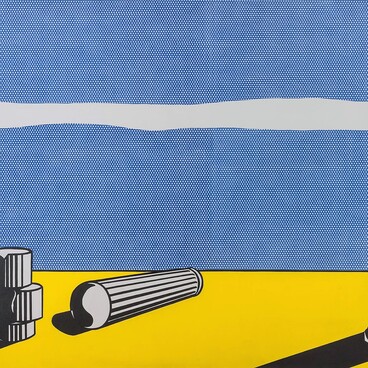The American painter and abstract sculptor Cy Twombly (1928–2011) created the painting housed by the Ludwig Museum in 1968. The German collectors Peter and Irene Ludwig donated it to the Russian Museum along with other paintings in 1994. At that time, Twombly was considered the most expensive living American artist.
The painting “Untitled” (1968) looks as if it has been drawn in chalk on a school board and resembles half-erased children’s scribbles. The background is dark blue and sometimes black. Against it, Cy Twombly sketched the outlines of numerous curved rectangles. The composition quotes one of the drawings by the Italian artist Leonardo da Vinci, depicting flying sheets of paper. Twombly lived in Italy for many years and often included references to Ancient and Renaissance art in his work.
Twombly arranged the sheets of various sizes diagonally to create the impression that they are flying in space. The artist emphasized the contrast between the dynamic movement and the static numbers and marks. Researchers offer different interpretations of Twombly’s works: from primitive “magical petroglyphs” on cave walls to children’s drawings.
The style in which Cy Twombly worked is also defined in different ways. His manner of painting is referred to as “abstract expressionism”. Some of his paintings are characterized as pop art.
Cy Twombly perceived the canvas as a surface onto which one can project his or her mental and physical nature. The artist created works by randomly applying inscriptions, lines and scratches to the canvas. Twombly often used the iconography of everyday life — things that surrounds a person every day. For example, numbers, letters, random items, and stencils.
Since 1957, Twombly has lived in Rome. From that time on, he has quoted the paintings of old Italian masters in his works. They appeared in the titles of works or in phrases on the surface of the canvas. Twombly’s mature painting consisted mainly of white canvases on which the artist painted with pastels, pencils and oil, creating lettering that looked like graffitti.
During his lifetime Cy Twombly became the third contemporary artist in history invited to display his work in the permanent exhibition of the French Louvre.
The painting “Untitled” (1968) looks as if it has been drawn in chalk on a school board and resembles half-erased children’s scribbles. The background is dark blue and sometimes black. Against it, Cy Twombly sketched the outlines of numerous curved rectangles. The composition quotes one of the drawings by the Italian artist Leonardo da Vinci, depicting flying sheets of paper. Twombly lived in Italy for many years and often included references to Ancient and Renaissance art in his work.
Twombly arranged the sheets of various sizes diagonally to create the impression that they are flying in space. The artist emphasized the contrast between the dynamic movement and the static numbers and marks. Researchers offer different interpretations of Twombly’s works: from primitive “magical petroglyphs” on cave walls to children’s drawings.
The style in which Cy Twombly worked is also defined in different ways. His manner of painting is referred to as “abstract expressionism”. Some of his paintings are characterized as pop art.
Cy Twombly perceived the canvas as a surface onto which one can project his or her mental and physical nature. The artist created works by randomly applying inscriptions, lines and scratches to the canvas. Twombly often used the iconography of everyday life — things that surrounds a person every day. For example, numbers, letters, random items, and stencils.
Since 1957, Twombly has lived in Rome. From that time on, he has quoted the paintings of old Italian masters in his works. They appeared in the titles of works or in phrases on the surface of the canvas. Twombly’s mature painting consisted mainly of white canvases on which the artist painted with pastels, pencils and oil, creating lettering that looked like graffitti.
During his lifetime Cy Twombly became the third contemporary artist in history invited to display his work in the permanent exhibition of the French Louvre.



